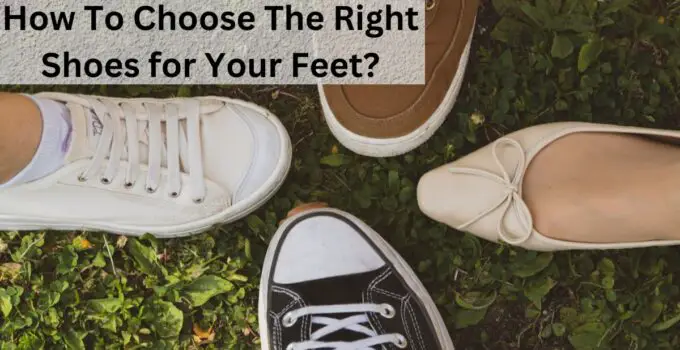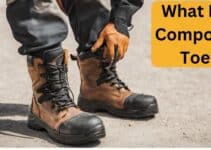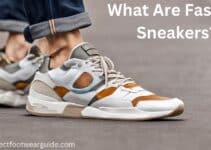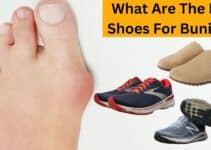Choosing the right shoes for your feet is essential for overall foot health and comfort. Ill-fitting shoes can lead to various problems, from blisters to chronic foot conditions. In this comprehensive guide, we will explore how to choose the right shoes for your feet well and support your unique foot type. Let’s dive in to ensure your feet stay happy and healthy with the perfect pair of shoes.
How to Choose the Right Shoes for Your Feet: Understanding Your Foot Type
Identifying different foot types:
- Flat Feet: Feet with low or no arches, causing the entire sole to touch the ground when standing.
- High Arches: Feet with elevated arches, resulting in less surface area touching the ground.
- Neutral Feet: Feet with a moderate arch that distributes weight evenly across the foot.
Importance of knowing your foot type for shoe selection:
- Your foot type impacts how weight is distributed and how much support you need from your shoes.
- Wearing shoes that match your foot type can prevent discomfort, pain, and potential foot problems.
Methods for determining your foot type:
1- Wet Test: Wet the bottom of your foot and step onto a surface showing your footprint.
- Flat feet: Full footprint with little to no arch.
- High arches: Narrow footprint with a pronounced arch.
- Neutral feet: Moderate footprint with a visible but not exaggerated arch.
2- Shoe Wear Patterns: Examine the wear patterns on your old shoes.
- Flat feet: More wear on the inside of the shoe.
- High arches: More wear on the outside of the shoe.
- Neutral feet: Even wear across the sole.
Professional Analysis: Visit a podiatrist or shoe specialist for a professional assessment.
They can conduct tests and provide personalized recommendations based on your foot structure and needs. Understanding your foot type is the first step towards finding the perfect shoes that support and comfort your feet.
Factors to Consider When Choosing Shoes
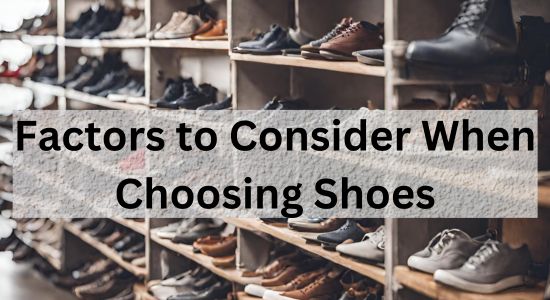
1- Comfort as a priority:
- Comfort is paramount when selecting shoes to ensure a pleasant wearing experience.
- Look for shoes with ample cushioning, soft materials, and a supportive fit to enhance comfort.
2- Proper fit and sizing guidelines:
- Shoes should fit snugly but not too tight, with enough room for toes to wiggle.
- Consider trying on shoes in the afternoon or evening when feet are slightly larger.
- Check for proper length and width by ensuring a thumb’s space width between the longest toe and the shoe’s end.
3- Arch support and cushioning:
- Choose shoes with adequate arch support corresponding to your foot type.
- Look for cushioned insoles or midsoles to absorb shock and reduce pressure on the feet.
4- Shoe construction materials:
- Opt for breathable materials like leather, mesh, or synthetic fabrics to promote airflow and prevent moisture buildup.
- Ensure the shoe’s construction is durable and flexible, allowing for natural foot movement.
5- Breathability and moisture-wicking properties:
- Shoes with breathable materials help prevent excessive sweating and odor.
- Look for moisture-wicking linings or inserts that draw sweat away from the skin to keep feet dry and comfortable.
6- Flexibility and stability features:
- Choose shoes that offer a balance of flexibility and stability to support natural foot motion.
- Look for grooved outsoles, reinforced heels, and supportive overlays to enhance stability without sacrificing flexibility.
- Considering these factors when choosing shoes ensures comfort, proper support, and functionality, leading to healthier and happier feet.
Tips for Specific Foot Conditions
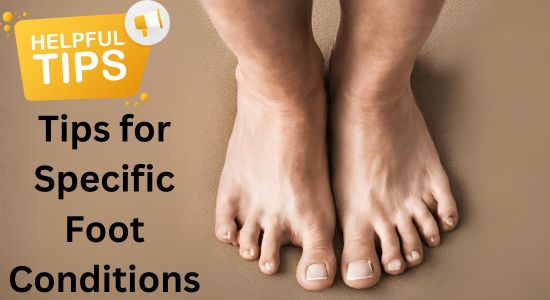
1- Shoes for flat feet:
- Look for shoes with arch support to help distribute weight evenly.
- Choose stability or motion-control shoes with firmer midsoles to prevent overpronation.
- Consider orthotic inserts or custom-made orthotics for additional support and alignment.
2- Shoes for high arches:
- Opt for shoes with extra cushioning to absorb shock and reduce pressure on the arches.
- Look for flexible, neutral, or cushioned shoes to accommodate the natural curve of high arches.
- Consider arch support inserts or custom orthotics to provide additional support and fill the arch gap.
3- Shoes for wide feet:
- Seek out shoes with wide-width options to accommodate the broader foot shape.
- Look for brands that offer specific wide-width models or styles with adjustable features like laces or straps.
- Choose shoes with spacious toe boxes to prevent crowding and allow natural toe splay.
4- Shoes for plantar fasciitis:
- Select shoes with good arch support and cushioning to alleviate pressure on the plantar fascia.
- Look for shoes with a slight heel lift to reduce strain on the Achilles tendon and calf muscles.
- Consider shoes with rocker bottoms or stiff soles to minimize foot bending and reduce tension on the plantar fascia.
5- Shoes for bunions or other foot deformities:
- Choose shoes with wide-toe boxes to accommodate bunions and prevent rubbing or irritation.
- Look for soft, flexible materials that won’t exacerbate pressure points or cause discomfort.
- Consider shoes with adjustable features like straps or laces to customize the fit and reduce pressure on affected areas.
By selecting shoes tailored to specific foot conditions, individuals can alleviate discomfort, prevent injury, and promote overall health and well-being.
Shopping and Trying on Shoes
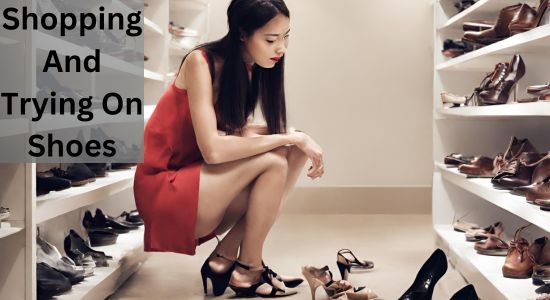
1- Where to shop for a variety of options:
- Specialty shoe stores: Visit stores specializing in footwear for specific needs, such as running athletic or comfort shoe stores for everyday wear.
- Online retailers: Explore online platforms that offer a wide selection of shoes in various styles, sizes, and widths.
- Department stores: Check out department stores for various shoe brands and styles, often at different price points.
2- Best times of day for trying on shoes:
- Try on shoes in the afternoon or evening when feet swell slightly, ensuring a better fit.
- Avoid trying on shoes first thing in the morning when feet are at their smallest.
3- Tips for getting the right fit in-store or online:
- Measure your feet: Use a Brannock device or a foot measuring guide to determine your accurate shoe size.
- Bring socks: Wear the socks you typically wear with the shoes to ensure proper fit and comfort.
- Walk around: Take a few steps in the shoes to test comfort, support, and fit.
- Check for space: Ensure enough room in the toe box, and the shoes don’t pinch or rub anywhere.
- Consider return policies: If shopping online, review the retailer’s return policy to ensure you can exchange or return the shoes if they don’t fit properly.
4- Additional considerations for online shoe shopping:
- Read reviews: Look for customer reviews to gauge sizing, comfort, and overall shoe satisfaction.
- Check sizing charts: Pay attention to sizing charts provided by the retailer to select the correct size based on measurements.
- Order multiple sizes: If you need more clarification on sizing, consider ordering various sizes to try at home and return the ones that don’t fit.
Whether in-store or online, following these tips can help you find the perfect shoes that fit well, feel comfortable, and meet your needs and preferences.
Maintaining Foot Health with Proper Footwear
Recognizing signs of improper shoe fit:
Discomfort or pain: If you experience discomfort, pain, or rubbing while wearing shoes, it may indicate an improper fit.
Blistering or chafing: Blisters or chafing on your feet can result from shoes that are too tight or rub against your skin.
Corns or calluses: Pressure points caused by ill-fitting shoes can lead to the development of corns or calluses on your feet.
Importance of rotating shoes:
Rotate between multiple pairs of shoes to allow each pair to air out and maintain their shape.
Avoid wearing the same pair of shoes daily, which can lead to excessive wear and tear and increase the risk of foot problems.
Regular foot care practices:
Keep feet clean and dry: Wash your feet daily with soap and water, and dry them thoroughly, especially between the toes.
Trim toenails properly: Cut toenails straight across and avoid cutting them too short to prevent ingrown toenails.
Moisturize: Apply moisturizer to keep your feet soft and hydrated, but avoid applying it between the toes to prevent fungal infections.
Inspect feet regularly: Check your feet for any signs of injury, infection, or abnormality, such as cuts, redness, swelling, or changes in skin color.
When to replace shoes:
Monitor the condition of your shoes and replace them when they show signs of wear and tear, such as worn-out soles, flattened cushioning, or visible damage.
Generally, athletic shoes should be replaced every 300-500 miles of running or walking or every 6-12 months, even if they still appear in good condition.
Maintaining foot health with proper footwear and regular foot care practices can prevent discomfort, reduce the risk of foot problems, and enjoy long-term foot health and mobility.
Conclusion
Choosing the right shoes for your feet is essential for maintaining health and overall well-being. By understanding your foot type, considering various factors such as comfort, fit, support, and shopping wisely, you can find shoes that promote comfort and prevent discomfort and injury. Maintaining proper foot care practices and knowing when to replace your boots are crucial to ensuring foot health. Remember, your feet are the foundation of your body, so investing in proper footwear is an investment in your health and mobility. With the tips and guidelines in this comprehensive guide, you can make informed decisions and prioritize your foot health. Step into a world of comfort and support by choosing the right shoes for your feet.
How do I find the right shoes for my feet?
Finding the right shoes for your feet is like finding the perfect pair of jeans. It takes a bit of trial and error, but once you find the right fit, it’s like walking on clouds. Start by knowing your foot type, whether you have flat feet, high arches, or somewhere in between. Then, consider factors like comfort, support, and fit. Try on different styles and sizes, and be bold and ask for help from shoe specialists. Trust me, your feet will thank you for it!
What kind of shoes are best for your feet?
The best shoes for your feet are the ones that feel like they were made just for you. Look for shoes with good arch support that match your foot type – whether you have flat feet, high arches, or neutral feet. Cushioning is vital, too, especially if you’re on your feet all day. And remember fit – make sure your shoes are tight enough and tight enough, with enough room for your toes to wiggle comfortably. Ultimately, it’s all about finding shoes that support your feet and keep them happy and healthy.
How do I choose my shoes?
Choosing the right shoes is about finding the perfect balance between style and comfort. Start by knowing your foot type and any specific needs you might have, like extra support or cushioning. Then, consider factors like fit, materials, and flexibility. Try on different styles and sizes, and pay attention to how they feel on your feet. Trust your instincts. It is only if something feels right. And don’t be afraid to ask for advice from shoe experts. After all, they’re there to help you find the perfect pair!
How should shoes fit your feet?
Shoes should fit your feet like a glove – snug but not too tight, with enough room for your toes to move comfortably. Your heel should stay in place without slipping, and there shouldn’t be any pressure points or rubbing. Make sure there’s about a thumb’s width of space between your longest toe and the end of the shoe. Remember to walk around them to make sure they feel good in motion, too. Trust me, a little extra time spent finding the right fit is well worth it.
Is it better for shoes to be tight or loose?
Neither! The ideal fit for shoes is somewhere in between snug enough to feel secure but not so tight that they pinch or squeeze. You want enough room for your toes to wiggle comfortably and your feet to move naturally as you walk. Likewise, you don’t want them to be so loose that your feet slide inside or feel floppy when you walk. It’s all about finding that sweet spot where your shoes feel just right like they were made for you.
